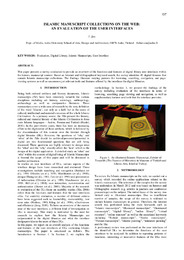| dc.contributor.author | Hakvoort, Gido. | en |
| dc.contributor.author | Ch'ng, Eugene. | en |
| dc.contributor.author | Beale, Russell. | en |
| dc.date.accessioned | 2013-02-13T10:41:09Z | en |
| dc.date.available | 2013-02-13T10:41:09Z | en |
| dc.date.issued | 2012-10-29 | en |
| dc.identifier.issn | 2047-4970 (Print) | en |
| dc.identifier.uri | http://hdl.handle.net/10797/6081 | en |
| dc.description.abstract | The beginning of the 21st century is an exciting time for museums in terms of new, engaging and interactive exhibits. Current technological developments offer museums ideal opportunities to meet the increasing expectations of their visitors, many of whom are the younger generation growing up in the digital age. With a multitude of devices and objects as well as people incorporated into an ever-growing network of interconnected systems, new patterns, forms of interactions and social relations will emerge. In order to engage visitors, museums are adopting new technologies which come with many possibilities, but also have their individual challenges and limitations. Museums should start looking at the unification of many such technologies in order to capture visitor attention, engage visitor interaction and facilitate social activities, since the large quantity of digital input and output capabilities of these technologies are hidden potentials. However, unless specifically designed for, many of these capabilities remain hidden and technologies remain oblivious of each other's features. Making them aware of each other's capabilities opens the channels for new synergy and engaging experiences for museum visitors. This paper proposes a framework which uniquely identifies a community of people, artefacts and devices within the museum environment and provides the means to discover, and make use of the technological properties of each element, treating them as an interacting ecosystem of complex adaptive systems and networks in physical spaces. | en |
| dc.description.sponsorship | Heritage and Cultural Learning Hub, University of Birmingham, B15 2TT UK, School of Computer Science, University of Birmin gham, Birmingham, B15 2TT UK. | en |
| dc.language.iso | eng | en |
| dc.publisher | Multi Science Publishing | en |
| dc.relation.ispartof | International Journal of Heritage in the Digital Era, Volume 1, Supplement 1, Pages 119-124 | en |
| dc.rights | info:eu-repo/semantics/openAccess | en |
| dc.subject | Interactive exhibits | en |
| dc.subject | Mobile technologies | en |
| dc.subject | Interactive displays | en |
| dc.subject | Museum visitors | en |
| dc.subject | Visitor engagement | en |
| dc.subject | Interaction framework | en |
| dc.title | The Museum Environment: A Complex Community of Objects, Peloep and Devices | en |
| dc.type | info:eu-repo/semantics/conferenceObject | en |
| dc.identifier.doi | 10.1260/2047-4970.1.0.119 | en |
